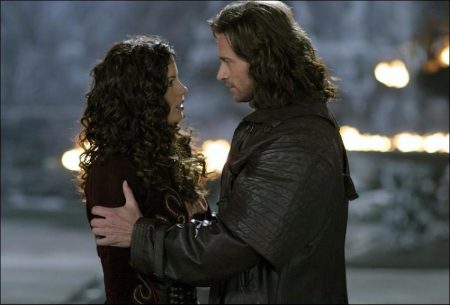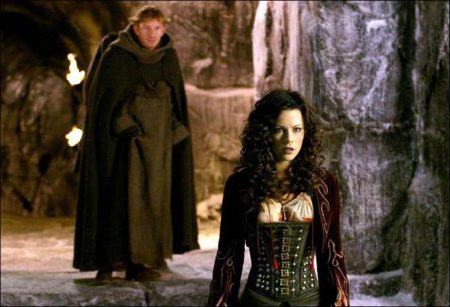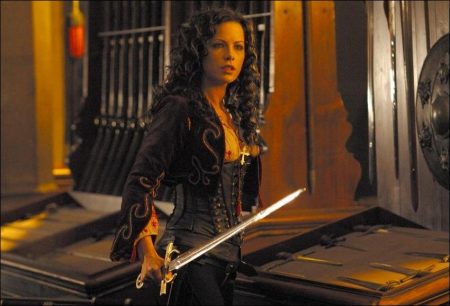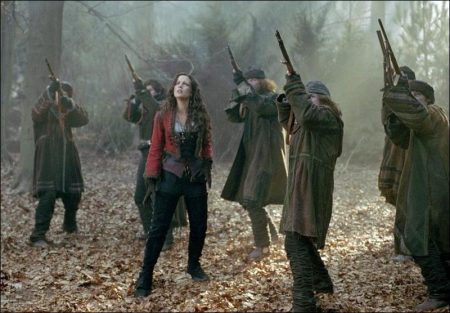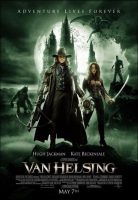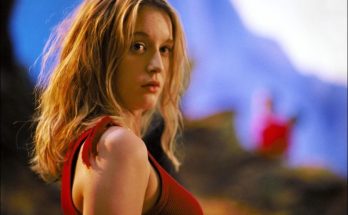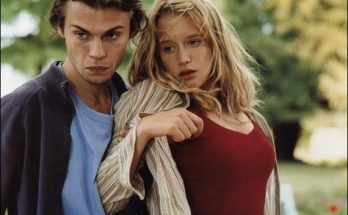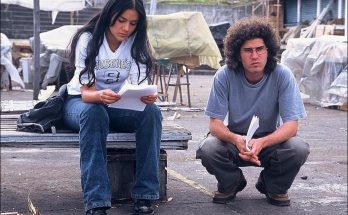Van Helsing Movie Trailer. Stephen Sommers, the innovative filmmaker behind the worldwide successes of The Mummy and The Mummy Returns, now takes audiences to an action-filled, fantastical world, where the iconic monsters of cinema legend meet the famed monster hunter out to vanquish evil in all its forms: Van Helsing.
Joining Jackman and Beckinsale are an international cast of superlative performers from the worlds of motion pictures and theater: Richard Roxburgh (Moulin Rouge!) as Count Dracula; David Wenham (The Lord of the Rings: The Return of the King) as Carl, a friar entrusted with ensuring Van Helsing’s safety; Will Kemp (former Matthew Bourne company leading dancer) as Velkan, Anna’s brother who transforms under the full moon into The Wolf Man; Kevin J. O’Connor (The Mummy) as Igor, the treacherous assistant to both Dr. Frankenstein and Count Dracula; Shuler Hensley (Tony-winning star of Broadway’s Oklahoma!) as The Frankenstein Monster, Dr. Victor Frankenstein’s misunderstood, persecuted creature; and, as Dracula’s three alluring, bloodthirsty Brides, Spain’s Elena Anaya (Sex and Lucia), Italy’s Silvia Colloca (in her American feature film debut) and Josie Maran (the upcoming The Aviator).
The Story Of The Story
Following the phenomenal success of both The Mummy and The Mummy Returns, imaginative writer/director Stephen Sommers was casting around for a change of pace. He was seeking an equally intriguing idea on par with those behind his worldwide hits, but something different. Eventually, he became compelled with a concept that would continue to exploit his superlative skill of presenting intriguing characters involved in exciting action stories, told on an epic canvas with decidedly up-to-date sensibilities. His keen storytelling sense led him to a deep well rich with characters primed for a revitalized action-adventure comeback.
The filmmaker states, “People had been kidding me, saying, `Hey, you did The Mummy, so when are you going to do Dracula?’ But that seemed limiting and already done. So I was thinking that it would be cool if all of the classic Universal monsters could be brought together somehow.”
That idea stayed with Sommers and drove him to re-examine the classic monsters from the studio’s canon-the cinematic hallmark which had helped turn Universal Studios into a Hollywood leader more than seven decades ago. Sommers set out to breathe life into these iconic creatures and set them in an vividly rendered world, brought back from the dead (as it were) through the use of unsurpassed production values, the latest in visual effects technology and a breathlessly paced, action-filled screenplay rooted in both re-invention and a keen appreciation for its inspirational ancestry.
“I didn’t pitch it before I started writing it, because I wasn’t sure I could write it,” he says. In the script, Sommers was determined to link the existences of the monsters, giving them involved, on-screen relationships far beyond mere coincidence or happenstance.
“I wondered how I could take these legends and have it so their characters and stories all intersect. The connecting premise needed to be both true to the characters’ popular mythologies and organic at the same time-I couldn’t just have a hero taking on the three monsters for no reason.
Then it struck me: What if Dracula had a life-and-death reason for needing Dr. Frankenstein’s Monster? Memorable villains always have really good reasons for what they’re doing. For a story like this to be interesting, there has to be a motivation behind the evil. His simple need to kill people for their blood has been so established and explored in films and books. So as soon as I hit on what might be driving Dracula, what his motivation was, everything started to come together,” Sommers explains.
Comments Bob Ducsay, producer/editor and 15-year filmmaking partner to Sommers, “The single greatest thing about Stephen is he’s a wonderful storyteller. For him, story is everything. As much as he infuses his movies with action, visual effects and production design, what stays foremost when he’s making the movie is `what’s the story here?’ And that starts with his characters.”
The writer/director continued his welcomed homework into the legendary characters (returning to the Universal films from the 1930s and `40s) and decided not only to look beyond the accepted mythology, but to also bend the rules when it came time to customizing the characters for his larger-than-life canvas.
“What I tend to do is look at these myths and then try to explain them. For instance, we know we can’t see Dracula’s reflection, so my natural curiosity as a filmmaker asks, `Why?’ If the mythology doesn’t provide an answer, then I supply one of my own. I realized that Frankenstein’s Monster, Dracula and The Wolf Man could all exist in the same world-the setting for all of their legends is Eastern Europe around the same time. Then I would come across something else, like when I read that werewolves were supposedly the guardians of vampires during the day. I started to be really excited by the potential of a film that could include all of these ideas and storylines.”
The ultimate linking piece to Sommers’ narrative puzzle lay in a character created by classic author Bram Stoker within the pages of his monolithic 1897 work of monster fiction: Dracula.
Sommers continues, “I read the book about 20 years ago. In Stoker’s novel, Van Helsing is 60 years old and his first name is Abraham. He’s been a character in countless movies, but no one’s ever done a movie centered on him. I needed to find a way to make him my own. I changed his first name to Gabriel and I made him younger and cooler…in a sense, I made my Van Helsing the younger brother to Stoker’s character. He’s now working for an ancient, secret society as a bounty hunter. He’s a gun-for-hire, a mercenary who is out to vanquish evil-and Count Dracula is evil incarnate, so he makes a very attractive quarry for Van Helsing.”
While this more adrenalized version of Van Helsing would serve as both a classic movie hero and crossroads for all of the monsters’ stories, Sommers went a step further by painting the character with equal amounts of light and darkness.
He adds, “I gave Van Helsing a motivating back story. The character, as I imagined him, doesn’t know who he is or where he is in his life. He doesn’t remember anything about his past. And while Van Helsing is a hero, he’s also the most wanted man in the land. He kills monsters that people are starting not to believe in any more-we’re nearing the end of the 19th century and the dawn of a more reasoned, enlightened period. When Van Helsing kills a werewolf, for example, the monster turns back into a human at the moment of his death. Van Helsing is left standing over the body of a gentle old man. So, people naturally have some serious misgivings about Van Helsing and what he’s up to.”
Building A World
The decision to shoot primary location work in Prague came about for a variety of reasons. Ducsay elaborates, “We shot just slightly over half of the film in Prague, using practical locations there, along with soundstage work. We were able to take advantage of situations where we needed extras, and Prague offered us a number of things we wanted: cold, gloomy weather for the exterior shots; an incredible pool of extras with the right regional look; and the existing and amazing structures that date back centuries.”
Executive producer Sam Mercer adds, “We were able to take advantage of the culture and history that’s so readily available. Much of the architecture and some of the customs from 150 years ago-when our story is set-still exist here. We wanted to take our audiences into this world, and Prague provided it.”
But while some locations could fit into Sommers’ fantastical vision of 19th century Europe, a great many of the sets would have to be constructed, some on location in the Czech Republic at Prague’s Barrandov and Prague Studios and some on Southern Californian soundstages: Playa Vista Stages in Los Angeles (500,000 square-feet of former Hughes Aircraft Corporation hangars) and Downey Studios in Downey, CA (250,000 square-feet of a former NASA/Boeing facility). Perhaps most spectacular was the re-creation of an entire Transylvanian village, built in Kunratice, just outside of Prague, that harkens back to the medieval period, replete with town square, two graveyards and more than a dozen hyper-Gothic structures, including a steepled church.
Ducsay comments,“The largest soundstage sets that we have are at Downey Studios-the interior of Castle Dracula’s entrance hall, along with the two towers and its bridge. Dracula’s entrance hall was built outdoors as an exterior because the set is so large, but it’s actually an interior set. We had to shoot there only at night, because the scenes involving the set don’t take place in the daytime.”
Van Helsing (2004)
Directed by: Stephen Sommers
Starring: Hugh Jackman, Kate Beckinsale, Richard Roxburgh, David Wenham, Shuler Hensley, Will Kemp, Kevin J. O’Connor, Elena Anaya, Silvia Colloca, Josie Maran, Sam West
Screenplay by: Stephen Sommers
Production Design by: Allan Cameron
Cinematography by: Allen Daviau
Film Editing by: Bob Ducsay
Costume Design by: Gabriella Pescucci
Set Decoration by: Cindy Carr, Anna Pinnock
Art Direction by: Steve Arnold, Keith P. Cunningham, Giles Masters
Tony Reading, Jaromír Svarc
Music by: Alan Silvestri
MPAA Rating: PG-13 for nonstop creature action violence and frightening images, and for sensuality.
Distributed by: Universal Pictures
Release Date: May 7, 2004
Views: 95
